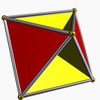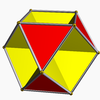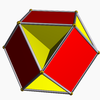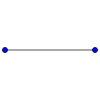
Euler characteristic
About this schools Wikipedia selection
SOS Children produced this website for schools as well as this video website about Africa. Before you decide about sponsoring a child, why not learn about different sponsorship charities first?
In mathematics, and more specifically in algebraic topology and polyhedral combinatorics, the Euler characteristic (or Euler–Poincaré characteristic) is a topological invariant, a number that describes a topological space's shape or structure regardless of the way it is bent. It is commonly denoted by  (Greek letter chi).
(Greek letter chi).
The Euler characteristic was originally defined for polyhedra and used to prove various theorems about them, including the classification of the Platonic solids. Leonhard Euler, for whom the concept is named, was responsible for much of this early work. In modern mathematics, the Euler characteristic arises from homology and connects to many other invariants.
Polyhedra
The Euler characteristic  was classically defined for the surfaces of polyhedra, according to the formula
was classically defined for the surfaces of polyhedra, according to the formula
where V, E, and F are respectively the numbers of vertices (corners), edges and faces in the given polyhedron. Any convex polyhedron's surface has Euler characteristic
This result is known as Euler's formula. This corresponds to the Euler characteristic of the sphere (which is 2), and applies identically to spherical polyhedra. An illustration of the formula on some polyhedra is given below.
| Name | Image | Vertices V |
Edges E |
Faces F |
Euler characteristic: V − E + F |
|---|---|---|---|---|---|
| Tetrahedron |  |
4 | 6 | 4 | 2 |
| Hexahedron or cube |  |
8 | 12 | 6 | 2 |
| Octahedron |  |
6 | 12 | 8 | 2 |
| Dodecahedron |  |
20 | 30 | 12 | 2 |
| Icosahedron |  |
12 | 30 | 20 | 2 |
The surfaces of nonconvex polyhedra can have various Euler characteristics;
| Name | Image | Vertices V |
Edges E |
Faces F |
Euler characteristic: V − E + F |
|---|---|---|---|---|---|
| Tetrahemihexahedron |  |
6 | 12 | 7 | 1 |
| Octahemioctahedron |  |
12 | 24 | 12 | 0 |
| Cubohemioctahedron |  |
12 | 24 | 10 | −2 |
| Great icosahedron |  |
12 | 30 | 20 | 2 |
A modified form of Euler's formula, using polyhedral density (D) and polygon density of the vertex figures ( ) and faces (
) and faces ( ) was given by Arthur Cayley, and holds both for convex polyhedra (where the correction factors are all 1), and the regular non-convex Kepler–Poinsot polyhedrons:
) was given by Arthur Cayley, and holds both for convex polyhedra (where the correction factors are all 1), and the regular non-convex Kepler–Poinsot polyhedrons:
Further, projective polyhedra all have Euler characteristic 1, corresponding to the real projective plane, while toroidal polyhedra all have Euler characteristic 0, corresponding to the torus.
Planar graphs
The Euler characteristic can be defined for connected planar graphs by the same  formula as for polyhedral surfaces, where F is the number of faces in the graph, including the exterior face.
formula as for polyhedral surfaces, where F is the number of faces in the graph, including the exterior face.
The Euler characteristic of any planar graph is 2. For via stereographic projection the plane maps to the two-dimensional sphere, such that the graph maps to a polygonal decomposition of the sphere, which has Euler characteristic 2. This viewpoint is implicit in Cauchy's proof of Euler's formula given below.
Proof of Euler's formula
The first rigorous proof of Euler's formula, given by Cauchy in 1811, is as follows.
Remove one face of the polyhedral surface. By pulling the edges of the missing face away from each other, deform all the rest into a planar graph of points and curves, as illustrated by the first of the three graphs for the special case of the cube. (The assumption that the polyhedral surface is homeomorphic to the sphere at the beginning is what makes this possible.) After this deformation, the regular faces are generally not regular anymore. The number of vertices and edges has remained the same, but the number of faces has been reduced by 1. As such, proving Euler's formula for the polyhedron reduces to proving V − E + F =1 for this deformed, planar object.
If there is a face with more than three sides, draw a diagonal—that is, a curve through the face connecting two vertices that aren't connected yet. This adds one edge and one face and does not change the number of vertices, so it does not change the quantity V − E + F. Continue adding edges in this manner until all of the faces are triangular.
Apply repeatedly either of the following two transformations:
- Remove a triangle with only one edge adjacent to the exterior, as illustrated by the second graph. This decreases the number of edges and faces by one each and does not change the number of vertices, so it preserves V − E + F.
- Remove a triangle with two edges shared by the exterior of the network, as illustrated by the third graph. Each triangle removal removes a vertex, two edges and one face, so it preserves V − E + F.
Repeat these two steps, one after the other, until only one triangle remains.
At this point the lone triangle has V = 3, E = 3, and F = 1, so that V − E + F = 1. Since each of the two above transformation steps preserved this quantity, we have shown V − E + F = 1 for the deformed, planar object thus demonstrating V − E + F = 2 for the polyhedron. This proves the theorem.
For additional proofs, see Nineteen Proofs of Euler's Formula by David Eppstein. Multiple proofs, including their flaws and limitations, are used as examples in Proofs and Refutations by Imre Lakatos.
Topological definition
The polyhedral surfaces discussed above are, in modern language, two-dimensional finite CW-complexes. (When only triangular faces are used, they are two-dimensional finite simplicial complexes.) In general, for any finite CW-complex, the Euler characteristic can be defined as the alternating sum
where kn denotes the number of cells of dimension n in the complex.
More generally still, for any topological space, we can define the nth Betti number bn as the rank of the n-th singular homology group. The Euler characteristic can then be defined as the alternating sum
This quantity is well-defined if the Betti numbers are all finite and if they are zero beyond a certain index n0. For simplicial complexes, this is not the same definition as in the previous paragraph but a homology computation shows that the two definitions will give the same value for  .
.
Properties
As a corollary of Poincaré duality, the Euler characteristic of any closed odd-dimensional manifold is zero. This applies more generally to any compact stratified space all of whose strata are odd-dimensional. Furthermore, the Euler characteristic behaves well with respect to many basic operations on topological spaces, as follows.
Homotopy invariance
Since the homology is a topological invariant (in fact, a homotopy invariant — two topological spaces that are homotopy equivalent have isomorphic homology groups), so is the Euler characteristic.
For example, any convex polyhedron is homeomorphic to the three-dimensional ball, so its surface is homeomorphic (hence homotopy equivalent) to the two-dimensional sphere, which has Euler characteristic 2. This explains why convex polyhedra have Euler characteristic 2.
Inclusion-exclusion principle
If M and N are any two topological spaces, then the Euler characteristic of their disjoint union is the sum of their Euler characteristics, since homology is additive under disjoint union:
More generally, if M and N are subspaces of a larger space X, then so are their union and intersection. In some cases, the Euler characteristic obeys a version of the inclusion-exclusion principle:
This is true in the following cases:
- if M and N are an excisive couple. In particular, if the interiors of M and N inside the union still cover the union.
- if X is a locally compact space, and one uses Euler characteristics with compact supports, no assumptions on M or N are needed.
- if X is a stratified space all of whose strata are even dimensional, the inclusion-exclusion principle holds if M and N are unions of strata. This applies in particular if M and N are subvarieties of a complex algebraic variety.
In general, the inclusion-exclusion principle is false. A counterexample is given by taking X to be the real line, M a subset consisting of one point and N the complement of M.
Product property
Also, the Euler characteristic of any product space M × N is
These addition and multiplication properties are also enjoyed by cardinality of sets. In this way, the Euler characteristic can be viewed as a generalisation of cardinality; see .
Covering spaces
Similarly, for an k-sheeted covering space  one has
one has
More generally, for a ramified covering space, the Euler characteristic of the cover can be computed from the above, with a correction factor for the ramification points, which yields the Riemann–Hurwitz formula.
Fibration property
The product property holds much more generally, for fibrations with certain conditions.
If  is a fibration with fibre F, with the base B path-connected, and the fibration is orientable over a field K, then the Euler characteristic with coefficients in the field K satisfies the product property:
is a fibration with fibre F, with the base B path-connected, and the fibration is orientable over a field K, then the Euler characteristic with coefficients in the field K satisfies the product property:
This includes product spaces and covering spaces as special cases, and can be proven by the Serre spectral sequence on homology of a fibration.
For fibre bundles, this can also be understood in terms of a transfer map  – note that this is a lifting and goes "the wrong way" – whose composition with the projection map
– note that this is a lifting and goes "the wrong way" – whose composition with the projection map  is multiplication by the Euler class of the fibre:
is multiplication by the Euler class of the fibre:
Relations to other invariants
The Euler characteristic of a closed orientable surface can be calculated from its genus g (the number of tori in a connected sum decomposition of the surface; intuitively, the number of "handles") as
The Euler characteristic of a closed non-orientable surface can be calculated from its non-orientable genus k (the number of real projective planes in a connected sum decomposition of the surface) as
For closed smooth manifolds, the Euler characteristic coincides with the Euler number, i.e., the Euler class of its tangent bundle evaluated on the fundamental class of a manifold. The Euler class, in turn, relates to all other characteristic classes of vector bundles.
For closed Riemannian manifolds, the Euler characteristic can also be found by integrating the curvature; see the Gauss–Bonnet theorem for the two-dimensional case and the generalized Gauss–Bonnet theorem for the general case.
A discrete analog of the Gauss–Bonnet theorem is Descartes' theorem that the "total defect" of a polyhedron, measured in full circles, is the Euler characteristic of the polyhedron; see defect (geometry).
Hadwiger's theorem characterizes the Euler characteristic as the unique ( up to scalar multiplication) translation-invariant, finitely additive, not-necessarily-nonnegative set function defined on finite unions of compact convex sets in Rn that is "homogeneous of degree 0".
Examples
The Euler characteristic can be calculated easily for general surfaces by finding a polygonization of the surface (that is, a description as a CW-complex) and using the above definitions.
| Name | Image | Euler characteristic |
|---|---|---|
| Interval |  |
1 |
| Circle |  |
0 |
| Disk |  |
1 |
| Sphere |  |
2 |
| Torus (Product of two circles) |
 |
0 |
| Double torus |  |
−2 |
| Triple torus |  |
−4 |
| Real projective plane |  |
1 |
| Möbius strip |  |
0 |
| Klein bottle |  |
0 |
| Two spheres (not connected) (Disjoint union of two spheres) |
  |
2 + 2 = 4 |
| Three spheres (not connected) (Disjoint union of three spheres) |
   |
2 + 2 + 2 = 6 |
Any contractible space (that is, one homotopy equivalent to a point) has trivial homology, meaning that the 0th Betti number is 1 and the others 0. Therefore its Euler characteristic is 1. This case includes Euclidean space  of any dimension, as well as the solid unit ball in any Euclidean space — the one-dimensional interval, the two-dimensional disk, the three-dimensional ball, etc.
of any dimension, as well as the solid unit ball in any Euclidean space — the one-dimensional interval, the two-dimensional disk, the three-dimensional ball, etc.
The n-dimensional sphere has Betti number 1 in dimensions 0 and n, and all other Betti numbers 0. Hence its Euler characteristic is  — that is, either 0 or 2.
— that is, either 0 or 2.
The n-dimensional real projective space is the quotient of the n-sphere by the antipodal map. It follows that its Euler characteristic is exactly half that of the corresponding sphere — either 0 or 1.
The n-dimensional torus is the product space of n circles. Its Euler characteristic is 0, by the product property. How many pentagons and hexagons does it take to make a Soccer ball? Assume we use  hexagons and
hexagons and  pentagons; then we have
pentagons; then we have  faces. Every pentagon (hexagon) has 5 vertices (6 vertices), and each one is shared between 3 faces, hence we have
faces. Every pentagon (hexagon) has 5 vertices (6 vertices), and each one is shared between 3 faces, hence we have  vertices. Similarly, every pentagon (hexagon) has 5 edges (6 edges), and each one is shared between 2 faces, hence we have
vertices. Similarly, every pentagon (hexagon) has 5 edges (6 edges), and each one is shared between 2 faces, hence we have  edges.
edges.
Since the sphere  has Euler characteristic 2, it must be that
has Euler characteristic 2, it must be that  . The result is that we always need 12 pentagons on a football/soccer ball; the number of hexagons is in principle unconstrained (but for a real football/soccer ball one obviously chooses a number that makes the ball as spherical as possible). One can also apply this result to fullerenes.
. The result is that we always need 12 pentagons on a football/soccer ball; the number of hexagons is in principle unconstrained (but for a real football/soccer ball one obviously chooses a number that makes the ball as spherical as possible). One can also apply this result to fullerenes.
Generalizations
For every combinatorial cell complex, one defines the Euler characteristic as the number of 0-cells, minus the number of 1-cells, plus the number of 2-cells, etc., if this alternating sum is finite. In particular, the Euler characteristic of a finite set is simply its cardinality, and the Euler characteristic of a graph is the number of vertices minus the number of edges.
More generally, one can define the Euler characteristic of any chain complex to be the alternating sum of the ranks of the homology groups of the chain complex.
A version used in algebraic geometry is as follows. For any sheaf  on a projective scheme X, one defines its Euler characteristic
on a projective scheme X, one defines its Euler characteristic
where  is the dimension of the i-th sheaf cohomology group of
is the dimension of the i-th sheaf cohomology group of  .
.
Another generalization of the concept of Euler characteristic on manifolds comes from orbifolds. While every manifold has an integer Euler characteristic, an orbifold can have a fractional Euler characteristic. For example, the teardrop orbifold has Euler characteristic 1 + 1/p, where p is a prime number corresponding to the cone angle 2π / p.
The concept of Euler characteristic of a bounded finite poset is another generalization, important in combinatorics. A poset is "bounded" if it has smallest and largest elements; call them 0 and 1. The Euler characteristic of such a poset is defined as the integer μ(0,1), where μ is the Möbius function in that poset's incidence algebra.
This can be further generalized by defining a Q-valued Euler characteristic for certain finite categories, a notion compatible with the Euler characteristics of graphs, orbifolds and posets mentioned above. In this setting, the Euler characteristic of a finite group or monoid G is 1/|G|, and the Euler characteristic of a finite groupoid is the sum of 1/|Gi|, where we picked one representative group Gi for each connected component of the groupoid.















